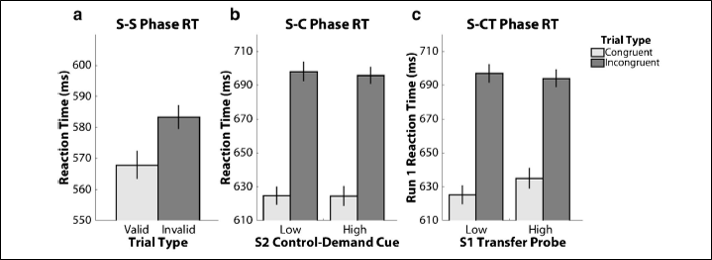There are some tasks that require cognitive processes that are habitual, automatic, and to some degree effortless, such as seeing a word and automatically reading it or seeing two numbers and automatically processing their magnitudes (e.g., seeing 5 and 3 and perceiving 5 to be greater).
There are other tasks that require cognitive processes that are slow and effortful, such as learning how to perform an unfamiliar task or making a decision about which car to purchase.
What’s more is that some tasks can initially require processes that are effortful, but with time and practice can be accomplished using processes that are more automatic and less effortful. For instance, learning to drive a car can start out as cognitively laborious, but quickly can lead to highway hypnosis. But for the truly special tasks where automatic and effortful cognitive processes are in conflict with one another, cognition really gets interesting!
Take for example the iconic Stroop task. In the standard color-word Stroop task, observers must identify the ink color of color-words while ignoring the actual printed word. The Stroop task is interesting because it combines two opposing forces within the same task. The automatic habitual response to read the color word interferes with the effortful task demand of naming the color word. This design has allowed researchers to evaluate processes that are automatic and implicit with those that are effortful and require cognitive control.
(Click here to try demos of variations of the Stroop task.)
Based on these examples we see that fast automatic and slow effortful processes can operate separately (e.g.. reading or making a tough decision), can operate sequentially (e.g., in driving), and can operate in opposition of one another (e.g. the Stroop task).
But what about these two types of processes working in concert with one another?
Recent evidence suggests that these two processes can work together. For instance, researchers have found that frequently pairing incongruent (high control-demand) Stroop items with a specific location on a screen can lead to more efficient processing of those incongruent items (smaller Stroop effect) compared to processing items at a different location (i.e. a location frequently associated with congruent, low control-demand Stroop items). In this way, quickly acquired, ‘effortless’ contextual cues can be used to strategically guide adjustments to effortful cognitive control demands.
To extend this finding, a recent article in Psychonomic Bulletin & Review, sought to evaluate if the learned stimulus cue–control state relationship can be transferred to closely associated contextual cues. That is, if the contextual cue that promotes adjustments to control demands is paired with a different cue, can the adjustment be transferred to that associated cue?  To test this hypothesis, researchers Christina Bejjani, Ziwei Zhang, and Tobias Egner implemented three experiments, each comprised of three phases: a Stimulus-Stimulus (S-S) association phase, a Stimulus-Control (S-C) association phase, and a Stimulus-Control Transfer (S-CT) test phase.
To test this hypothesis, researchers Christina Bejjani, Ziwei Zhang, and Tobias Egner implemented three experiments, each comprised of three phases: a Stimulus-Stimulus (S-S) association phase, a Stimulus-Control (S-C) association phase, and a Stimulus-Control Transfer (S-CT) test phase.
In the S-S phase, face and house (S1 in panel a in the figure below) images were repeatedly presented before scene (S2) images to establish S1 – S2 paired associations in memory (panel b shows sample trials). In the S-C phase (panel c), S2 images were repeatedly presented before color-word Stroop trials to create probabilistic cues for Stroop task items (incongruent and congruent items). Importantly, half of the S2 images were 80% predictive of incongruent Stroop items (similar to the location cue previously discussed), and the other half were 80% predictive of the congruent Stroop items. In the S-CT phase (panel d), S1 images instead of S2 images were presented before Stroop trials, but were not predictive of Stroop item congruency type.

If control state adjustment transferred to paired-associate cues, one would expect that S1 images associated with S2 high control-demand images would produce a smaller congruency effect in the transfer phase compared to S1 images associated with S2 low control demand images.
To explore performance in the task, Bejjani and colleagues conducted a number of analyses. Here we discuss a small subset. First, they compared the reaction time and accuracy on trials where S1 images were presented before their paired associates to trials where they were not in the S-S phase. They also assessed reaction time accuracy from Stroop trials following the S2 images as a function control demand cue (high demand vs low demand) and congruency (congruent vs incongruent) in the S-C phase. They further looked at reaction time and accuracy for trials following the S1 transfer probes in the S-CT phase.
They found that first, in the S-S phase, S2 images were categorized more quickly when validly cued with the associated S1 image. Second, in the S-C phase, as expected, they found that responses were slower and less accurate overall for incongruent trials compared with congruent trials (i.e. that standard Stroop effect). They also found better Stroop performance for the frequency biased trials compared to the frequency unbiased trials following both the high and low demand cues. Critically, in the S-CT phase, they found reduced congruency effects for the high compared to low demand S1 transfer probes.

Based on the results, the researchers concluded that people can learn to use fast processing to associate stimuli with specific effortful control states. In three experiments that demonstrated that learned stimulus cue – control associations could transfer to pre-learned cue associations.
Taken together, this work provides evidence for a generalized learning mechanism in which context-cue specific cognitive control can be generalized to previously linked cues.
Featured Psychonomic Society article:
Bejjani, C., Zhang, Z., & Egner, T. (2018). Control by association: Transfer of implicitly primed attentional states across linked stimuli. Psychonomic Bulletin & Review, DOI: 10.3758/s13423-018-1445-6.
